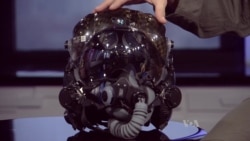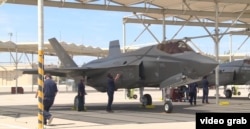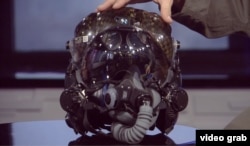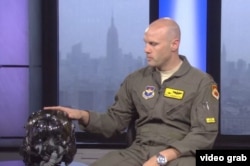The U.S. Air Force is on a mission. One of its top guns is touring the United States to promote the nation's newest fighter jet, the F-35 joint strike fighter.
“This plane, I can’t harp on it enough, this plane is the most advanced fighter aircraft we (the United States) have," Major Will “D-Rail” Andreotta told VOA. "I mean this is made for those threats that haven’t even been developed yet. That’s really why this plane is here.”
The F-35, also called the Lightning, possesses dazzling technological innovations.
Not only can it achieve a speed of Mach 1.6 in flight, or the equivalent of 1,900 kph (the Russian SU-34 fighter bomber also does this), it possesses stealth technology that enables it to avoid detection by radar. It can hover like a helicopter; it can take off and land vertically.
The plane is extremely complex, with several different versions for the Air Force, Navy and Marines, and a cost that exceeds $100 million per jet, excluding the engine.
“The F-35 is going to be the backbone of the fighter fleet of the future," said Andreotta, a highly decorated fighter pilot who served in Afghanistan.
Costly price tag
But the F-35 has also become a lightning rod for out-of-control Pentagon spending.
Critics point to faulty design and an effort to use it to fill multiple roles. The fighter jet has had reported troubles with ejector seats and the computer system.
So far, the entire program has cost more than $3.5 billion, and the plane is eight years late.
If there is one symbol for the F-35 controversy, it is the $400,000-plus pilot’s helmet.
The controversial helmet is basically a navigation system. When the pilot is looking straight and to the sides, he/she sees all of the weapons employment information in the helmet visor. The helmet has been described as a “workspace.”
Major Andreotta held up the helmet. “All the information that the jet brings into the aircraft is available to me in this helmet and that is why it is really more than a helmet. It’s actually an integral part of the F-35 system. It’s designed to provide pilots with 360-degree situational awareness in any kind of weather, day or night."
He described some of the intricacies.
“Up here at the top portion of it, this is the central computer of the helmet,” he said. “This is where all the information is processed and where it decides what it’s going to display to me.
"Out here, this visor, is what we call the display visor. So, it is where all the information is being projected into. These camera are really important. One is a camera that looks out. It also has my night vision camera. So gone are the days of me actually having to put night vision on, it’s now a flip of a switch," Andreotta said.
Dan Grazier, a Jack Shanahan Fellow for the Project On Government Oversight (POGO), said the group is in favor of a strong military, but not in favor of government waste, especially Pentagon waste.
“(The F-35) was, essentially, a conglomeration of a bunch of designers’ technological features and so it’s kind of forcing the military as they start to take this on to adjust the way they operate around this very expensive, and as yet, unproved piece of technology," Grazier said.
"Historically, it is a very unsuccessful concept of trying to fit multiple roles into one aircraft. That doesn’t tend to work," he added.
Grazier saved his harshest criticism for the helmet.
He said the way the plane is designed, the pilot sits very low in the cockpit so has limited visibility: "We get the added benefit of paying an extra half-million dollars or so on top of that for the complex helmet design to overcome something that they could have done with just simple engineering. ... It’s one more thing, one more piece inside this aircraft that can fail down the road.”
But he also leveled criticism at the military.
“I would really love a great answer from somebody about why an active duty air force officer is out conducting public relations work for Rockwell Collins and Lockheed Martin (F-35 contractors) ... trying to create excitement with regard to this helmet," Grazier said, referring to Andreotta.
Approximately 2,500 F-35 aircraft will be built for the U.S. Air Force, Navy and Marines, plus several hundred planes for participating allies.
There are nine countries in the F-35 program, and each has had input into the jet's manufacture.
Pilots from those countries are now training with the F-35 in Arizona under the tutelage of Andreotta, who has more than 1,850 flight hours to his credit.
The first of the planes already are in service. Full rollout is expected in 2037.














